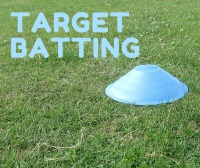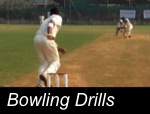|
 Here's a simple way to adapt a bowling drill so it can be used by batsmen. Here's a simple way to adapt a bowling drill so it can be used by batsmen.
The idea of "target bowling" is a classic for bowlers. So much so it has become a standard at every level. It's simple and easy: Run up and bowl at a cone on the pitch. Repeat until skilful. It works well because it's repeatable with instant feedback and results that can be tracked over time.
So it's about time the batsmen got on some target action too.
Lets call it target batting.
How do we set it up?
Just like the bowler, the batsman can set out a target and try to hit it. This is different from working on the technique of a shot. The goal is not to produce technical perfection, but to find ways to hit the ball into certain areas.
Set markers in the target area and have a feeder deliver the ball into the same place. You try and hit the ball into the area. If you hit it, you get a point. If you miss you don't.
There are two important elements:
- The feed must be consistent.
- The result must be instantly tracked.
If you try to do this with bowlers - either in nets or middle practice - then you get a mixture of speed and accuracy that will prevent you from getting the right kind of feedback. So, for this drill the feed has to be consistent. It can be throwdowns, a bowling machine or even simple underarm feeds.
Secondly, the outcome must be a pass or a fail. Unlike technical work, where you can do some things better than others, there is no middle ground. This is because the key to success is the ability to adjust based on the outcome. If you are improving your score will go up over time, if your method is not working your score will stay the same (or even go down).
Other than that, you have a lot of flexibility in the drill. You can do it in nets or in the middle. You can target any area, including over the top. You can do it with any kind of accurate feed. You can still work on technical things, as long as these things are designed to get you to hit the target area more often. The target area can be set by cones, mats or fielders. You can do it whatever your age, skill or level of technical perfection. Do the drill, note down your score and repeat over time.
The noting down is really important because we are very poor at remembering how well we did over time. Memory is not built for such things, so don't rely on it. Instead use a simple scoring system that you can review every week without trying to remember.
Drill progressions
For most of us, the basic drill is plenty. However, if you are looking to adjust the elements you want to improve, consider these changes:
- Mix up the feed a little bit by throwing in the odd different line or length ball. It's important this is occasional but enough to prevent premeditation of shots.
- More targets. If you want to improve your decision making, you can set larger areas or more areas to try and hit, but keep the ball feed the same. For more on this, click here.
It's important to stress these progressions change the point of the drill rather than make the drill more "advanced". The basic drill is advanced enough for even the best players.
Wouldn't it be great to see this drill at club nets?
The bowler's have target bowling, the batsmen have target batting and both get together at the end for some scenario practice. Much better than the usual "all bat all bowl" method.
Discuss this article with other subscribers
|

.jpg)



.jpg)

